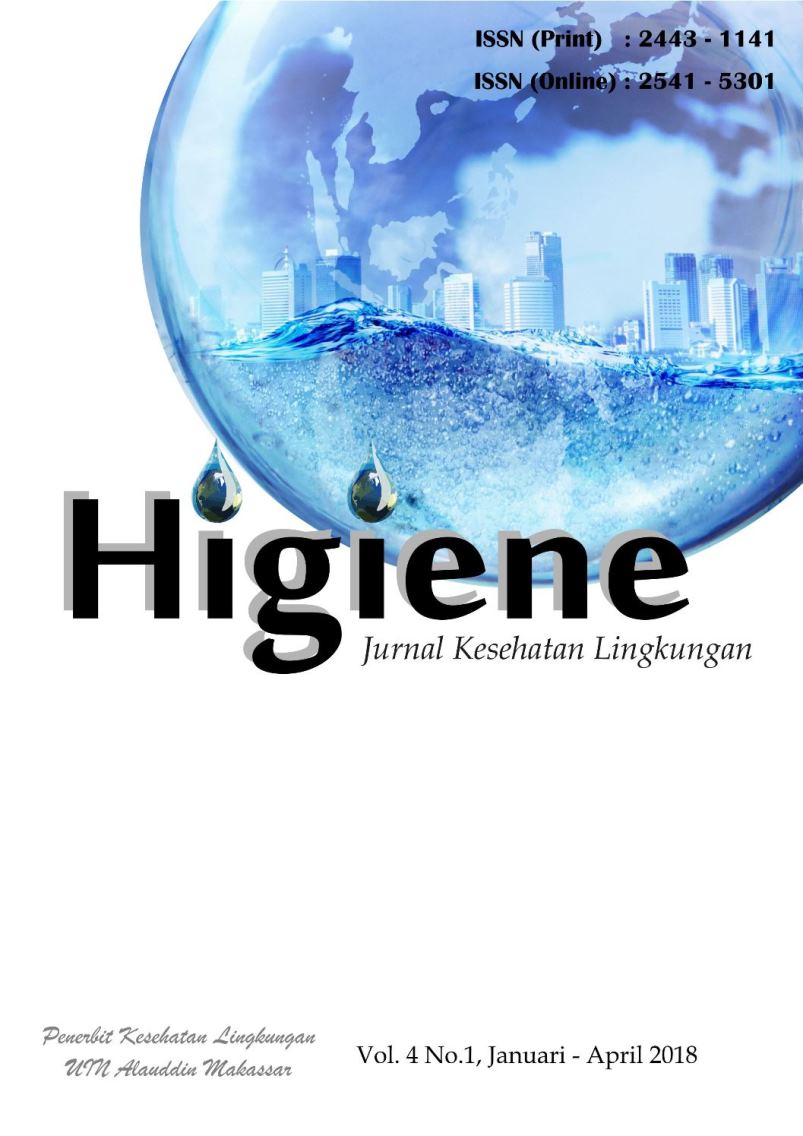Penurunan Kadar COD dengan Metode Filtrasi Multimedia Filter pada Air Limbah Laundry
Abstract
Laundering clothes and household appliances (laundry) is one of the bussiness engaged in services that are mounting. The small businessman laundering clothes (laundry) started in the big cities, many people who do not have time to wash his clothes himself because of his work. At first it was very helpful, but it will eventually arise environmental problems caused by waste. The waste that produced by the rest of the laundry process have the potential to cause pollution to the environment, especially on water bodies. The purpose of this research is to reduce levels of COD with a method filtration multimedia filters on the waste laundry by using a variety of a thickness of different media. This research is an experiment quasi, namely to know how percent efficiency decreased levels of COD with filtration multimedia filters on the waste laundry. The result of resesrch conducted by the filtration multimedia filters a variety of thickness of the first media average fell into 453,33 mg/l with the percentage decline 46,33 % and filtration multimedia filters a variety of thickness of the second media average fell into 320 mg/l with the percentage decline 63,07 %. The conclution of this experiment, filtration multimedia filters can reduce levels of COD water waste laundry but not efficient for not meeting the requirements of Souts Sulawesi Governor Regulation Number 69 year 2010 About The Requirements of the raw environmental damage the quality of life that level of COD allowed is 100 mg/l.
Keyword : Filtration, Carbon, Zeolite, COD, Waste Water Laundry.
References
Asmadi. (2011). Tekhnologi Pengolahan Air Minum. Yogyakarta : Gosyen Pubhlishing
Basri, S., & Hamzah, E. (2016). Efektivitas Kemampuan Tanaman Jeringau (Acorus calamus) untuk Menurunkan Kadar Logam Berat di Air. HIGIENE: Jurnal Kesehatan Lingkungan, 1(1), 49-59.
Buchman, H.O. dan N.C. Brady. (1982). Ilmu Tanah. Jakarta: Bhratara Karya Aksara
Budiman, Chandra. (2006), Pengantar Kesehatan Lingkungan. Jakarta : EGC.
Budiyono, & S, S. (2013). Teknik Pengolahan Air. Yogyakarta: Graha Ilmu.
Darmono. (2001). Lingkungan Hidup Dan Pencemaran Hubungannya dengan Toksikologi Senyawa Logam. Jakarta : Universitas Indonesia UIP
Daryanto. (2013). Pengantar Pendidikan Lingkungan Hidup. Yogyakarta : Gava Media
Indarto. (2010). Dasar Teori dan Contoh Aplikasi Model Hidrologi. Jakarta : Bumi Aksara.
Peraturan Gubernur Sulawesi Selatan Nomor : 69 Tahun 2010. Tentang Baku Mutu dan Kriteria Kerusakan Lingkungan Hidup.
Rukaesih, Achmad. 2004, Kimia Lingkungan. Jakarta : Andi
Ronny. (2016), Penyehatan Air. Politeknik Kesehatan Makassar. Jurusan Kesehatan Lingkungan.
Ronny. (2016). Dasar Dasar Kesehatan Lingkungan. Politeknik Kesehatan Makassar. Jurusan Kesehatan Lingkungan.
Sanropie, Djasio. (1984). Pedoman Bidang Studi Penyediaan Air Bersih Akademi Penilik Kesehatan-Teknologi Sanitasi (APK-TS). Jakarta : Pusdiklat Pegawai Depkes RI
Subarkah, Iman. (1974). Bangunan Air. Bandung : Idea Dharma
Sumantri Arif. (2015). Kesehatan Lingkungan. Jakarta : Kencana Prenada Media Group
Suprihatin dan Ono, Suparno. (2013). Teknologi Proses Pengolahan Air. Bogor : PT Penerbit IPB Press
Copyright (c) 2018 HIGIENE: Jurnal Kesehatan Lingkungan

This work is licensed under a Creative Commons Attribution 4.0 International License.


